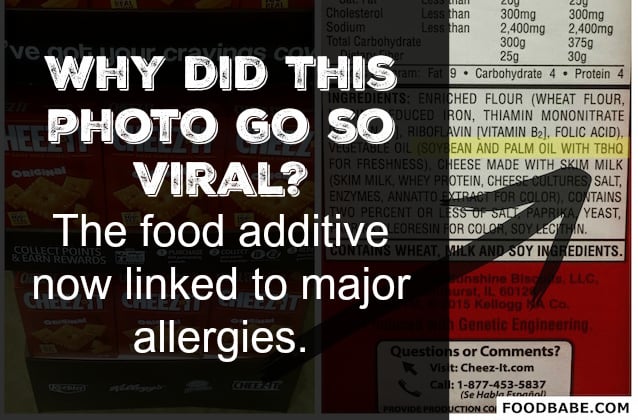Last week, I shared a picture of a popular snack that contains a very controversial preservative and it went absolutely viral. People (like you and me and so many others) care about what’s in their food and it’s a beautiful thing to see so many people sharing this information with those they love on social media. In fact, when a member of my team alerted me about this, I screamed “REVOLUTION!” so loud the house shook. This is a revolution and it can’t be stopped. We are sick of all the untested, controversial and shady chemicals the food industry invents to improve their bottom line. Wouldn’t it be great if they used their fancy chemistry to actually improve our health, instead? Or how about addressing the sudden rise of major food allergies? Which brings me to my point, have you seen the stats on food allergies lately?
- 1 in every 13 children have food allergies in the U.S.
- Food allergies in children increased approximately 50% between 1997 and 2011. (Yes, 50%!)
- Every 3 minutes, a food allergy reaction sends someone to the emergency room.
Something needs to be done to figure out what’s going on and I really feel for the parents who live in constant fear that their child will come in contact with something they are allergic to. I know from my own experience with family members who have life-threatening food allergies – it’s one of the scariest things you have to deal with. That’s why I’m really hopeful about some breaking new research coming out of Michigan State University that might finally get to the bottom of what could be triggering some of these serious food allergies.
Cheryl Rockwell, an assistant professor of pharmacology and toxicology at Michigan State University, uncovered during 9 years of research that the common food additive TBHQ (tert-butylhydroquinone)causes abnormal reactions in the immune system that trigger food allergies. She explains that TBHQ negatively affects “T-cells” in the body (which are generally used to fight infections) in a way that promotes allergies to tree nuts, milk, eggs, wheat and shellfish.
“Because humans are exposed to tBHQ through ingestion of food, the development of food allergies may be of particular concern. Notably, there has been an increase in reports of food allergy that seems to correlate with the increased use of tBHQ and other phenolic antioxidants as food preservatives.” ~ Cheryl Rockwell, PhD, The Journal of Immunology
Dr. Rockwell just received a large grant from the National Institute of Environmental Health Sciences to continue her research on TBHQ and its relation to human food allergies. While I highly doubt one single food additive is the cause of all food allergies, this is a move in the right direction. Ingredients are dumped into our food with zero independent or regulatory oversight – some of which trigger very serious allergic reactions and can have other negative effects on our health.
What is TBHQ?
One of my first big restaurant investigations was Chick-Fil-A, in which I found that they used the preservative TBHQ not once – but twice – in their chicken sandwiches as it was in both the chicken and the bun. This sandwich was one of my favorite foods to eat when I was younger, so this really hit home!
You can’t get much more toxic than TBHQ. This synthetic preservative is a form of butane and has been linked to vision disturbances, liver enlargement, childhood behavioral problems, and stomach cancer in animal studies. It’s also banned for use in food in other countries including Japan, and is on the Center For Science in The Public Interest’s list as one of the worst food additives to be avoided.
Even though TBHQ is technically an “antioxidant” which makes it sound healthy – it’s synthetically created in a lab. Other synthetic antioxidants include BHT and BHA, which the Environmental Working Group says should not be in our food.
Journalist Michael Pollan first alerted the masses to this ingredient 10 years ago in his bestselling book, The Omnivore’s Dilemma:
“But perhaps the most alarming ingredient in a Chicken McNugget is tertiary butylhydroquinone, or TBHQ, , an antioxidant derived from petroleum that is either sprayed directly on the nugget or the inside of the box it comes in to “help preserve freshness.” According to A Consumer’s Dictionary of Food Additives, TBHQ is a form of butane (i.e. lighter fluid) the FDA allows processors to use sparingly in our food: It can comprise no more than 0.02 percent of the oil in a nugget. Which is probably just as well, considering that ingesting a single gram of TBHQ can cause “nausea, vomiting, ringing in the ears, delirium, a sense of suffocation, and collapse.” Ingesting five grams of TBHQ can kill.” ~ Michael Pollan, The Omnivore’s Dilemma: A Natural History of Four Meals, 2006
McDonald’s has since removed the TBHQ. Despite the dangers, the FDA has allowed TBHQ in our food since 1972 and since then it has become so common that you can barely walk down a single aisle in the supermarket without running into products with it left and right.
When the World Health Organization evaluated the intake of TBHQ in the U.S., they found that people who regularly eat high fat foods are consuming 180% of the “acceptable daily intake”. In other words… WAY too much!
Soon afterI consulted Chick-Fil-A in 2012 and raised concerns about the TBHQ, they began testing peanut oil without it in multiple markets – and finally ditched it completely in 2015. They also didn’t replace it with some other toxic chemical, they just took it out. You’ve got to ask yourself, is this ingredient really necessary?
Beware: Avoiding TBHQ isn’t easy because it’s not always listed on the label…
Read full story here: Source: Why did this photo go so viral? The food additive now linked to major allergies.

